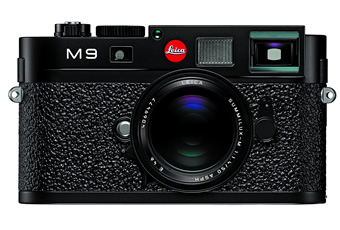I’m a big fan of the Leica M8.2 digital camera. So for me, the big news for today isn’t the announcement of the new Apple iPods or the remastered Beatles CDs — though both of those developments are important. For me, the place to be was the Leica press conference held in New York this morning for the unveiling of the new Leica M9 digital camera.
Rumors have been flying for weeks now about the M9’s imminent arrival. It didn’t take a rocket scientist to figure out that a 9:00 a.m. press conference on 09/09/09 might indicate something to do with a “9” designated product.
With a list price of $6,995 for just the camera body, the M9 clearly isn’t for everyone. However, based on my experience with the previous models, Leica has taken an incredible camera and made it even better. As good as the M8 and M8.2 are, they have two significant limitations. They don’t have a full frame sensor, and you have place an IR filter on each lens to prevent a color aberration from appearing in certain circumstances. The M9 solves both issues.
The M9 has a full frame sensor, which means a 28mm lens will function as a true 28mm lens (because of the 1.33 crop factor, a 28mm lens on an M8 or M8.2 has a field of view that’s closer to a 37mm lens). Equally important, there’s a significant increase in resolution because of the larger sensor size.
For the M9, Leica has brought the IR filter into the camera, so owners won’t have to add an IR filter to each lens. The IR issue might seem to be a flaw, but it’s actually a result of Leica’s obsession with delivering the sharpest possible image (it’s a long story — search Google for details).
The bottom line? The M9 is currently the smallest full-frame digital camera system. And it accepts the finest lenses in the world, which just happen to be manufactured by Leica. As you may have guessed, they aren’t cheap either, though there is a healthy market for used Leica lens. Essentially, any M-mount Leica lens going back to 1954 will be compatible. And third-party companies, including Zeiss and Cosina, manufacture new M-mount lenses that can be nearly as good as the Leica lenses, but cost far less.
Along with the M9, Leica introduced the X1 digital camera ($1,995 list price). Like the Sigma DP1 and DP2, it combines a sharp non-interchangeable fixed lens, DSLR-size sensor, and compact-size body. The X1 will produce terrific photos, though you won’t be able to change the focal length, as you can with any zoom lens. The DP1, DP2, and X1 have automatic focus, so they’re a better match than the M9 for camera buffs who aren’t quite ready to go mostly manual.
The Leica M9 doesn’t have automatic focus, but has what many regard to be the finest manual focus system available. Once you become acquainted with the M-series’ bright-line viewfinder, you may not want to go back to an automatic system where the camera always determines where to place the focus.
I’m only an amateur camera buff with limited talent, but I’ve been able to capture some of my best photos with a Leica M8.2, including this, this, this, this, this, this, and this.
